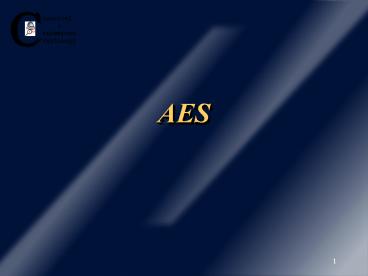AES - PowerPoint PPT Presentation
1 / 14
Title:
AES
Description:
It must be in the public domain royalty free world wide ... Variable number of rounds (iterations): 10, 12, 14. Number of rounds depend on key/block length ... – PowerPoint PPT presentation
Number of Views:522
Avg rating:3.0/5.0
Title: AES
1
AES
2
Advanced Encryption Standard
- Since DES was becoming less reliable as new
cryptanalysis techniques were developed, the
National Institute of Standards and Technology
(NIST) put out a notice in early 1999 requesting
submissions for a new encryption standard. The
requirements were - A symmetric block cipher with a variable length
key (128, 192, or 256 bits) and a 128-bit block - It must be more secure than TripleDES
- It must be in the public domain royalty free
world wide - It should remain secure for at least 30 years
- Fifteen algorithms were submitted from ten
different countries.
3
Submitted Algorithms
Australia LOKI97 Belgium RIJNDAEL Canada
CAST-256 DEAL Costa Rica FROG France DFC
Germany MAGENTA
Japan E2 Korea CRYPTON USA HPC MARS
RC6 SAFER TWOFISH UK, Israel, Norway
SERPENT
4
Selection Process
- NIST relied on public participation
- algorithm proposals
- cryptanalysis
- efficiency testing
- AES Timetable
- Round 1 Aug. 20 - April 15, 1999
- Submit papers for 2nd AES conference Feb 1, 1999
- Second AES conference March 22-23, 1999
- Announcement of (about) five finalists
- Round 2 analysis of finalists 6-9 months
- Third AES Conference
- Selection of AES Algorithm
5
AES Finalists
- MARS (IBM)
- RC6 (Rivest, et. al.)
- Rijndael (top Belgium cryptographers)
- Serpent (Anderson, Biham, Knudsen)
- Twofish (Schneier, et. al.)
And the winner was . . .
6
Introduction to Rijndael
- One of the fastest and strongest algorithms
- Variable block length 128, 192, 256 bits
- Variable key length 128, 192, 256 bits
- Variable number of rounds (iterations) 10, 12,
14 - Number of rounds depend on key/block length
7
Rijndael Structure
- The general structure of Rijndael is shown below
- Rather than using just a substitution and a
permutation at each stage like DES, Rijndael
consists of multiple cycles of Substitution,
Shifting, Column mixing and a KeyAdd operation.
KeyAdd
KeyAdd
8
Initial Step
- The process begins by grouping the plaintext bits
into a column array by bytes. - The first four bytes form the first column the
second four bytes form the second column, and so
on. - If the block size is 128 bits then this becomes a
4x4 array. For larger block sizes the array has
additional columns. - The key is also grouped into an array using the
same process.
9
Substitution
- The substitution layer uses a single S-box
(rather than the 8 Sboxes used in DES). The
Rijndael S-box is a 16 x 16 array - Each element in the current column array serves
as an address into the S-box where the first four
bits identify the S-box row and the last 4 bits
identify the S-box column. - The S-box element at that location replaces the
current column array element.
b1,2
a1,2
10
Row Shift Operation
- A row shift operation is applied to the output of
the S-box in which the four rows of the column
array are cyclically shifted to the left. - The first row is shifted by 0, the second by 1,
the third by 2, and the fourth by 3
11
Matrix Multiply
- Column mixing is accomplished by a matrix
multiplication operation. - The shifted column array is multiplied by a fixed
matrix
12
Key Add
- The final operation adds a subkey derived from
the original key to the column array - This completes one round of AES
This is repeated 9 more times
13
Key Schedule
- The key is grouped into a column array and then
expanded by adding 40 new columns. - If the first four columns (given by the key) are
C(0), C(1), C(2) and C(3) then the new columns
are generated in a recursive manner. - If i is not a multiple of 4 then column i is
determined by C(i) C(i-4)
XOR C(i-1) - If i is a multiple of 4 then column i is
determined by C(i) C(i-4)
XOR T(C(i-1)) - Where T(C(i-1)) is a transformation of C(i-1)
implemented as 1. Cyclically shift the
elements of C(i-1) by one byte 2. Use each
of these 4 bytes as input into the S-box to
create four new bytes e,f,g,h.
3. Calculate a round constant r(i) 2(i-4)/4
4. Create the transformed column as (e XOR
r(i), f, g, h) - The round key for the ith round consists of the
columns C(4i), C(4i1), C(4i2), C(4i3).
14
Key Generation Flow
- For whats worth































